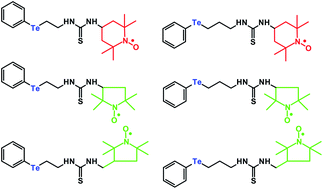Reactions of nitroxides 16. First nitroxides containing tellurium atom†
Abstract
2-Chloroethylamine hydrochloride and 3-chloropropylamine hydrochloride were converted with diphenyl ditelluride and sodium borohydride to primary amines containing the tellurium atom. Reaction of tellurium amines with thiophosgene gave the corresponding isothiocyanates, which in turn were transformed with nitroxyl amines to thioureas bearing both a nitroxyl moiety and a tellurium atom. Fungicidal activity of tellurium nitroxides was tested. 1-(2,2,6,6-Tetramethyl-1-oxyl-4-piperidinyl)-3-(3-(phenyltellanyl)propyl) thiourea showed high fungistatic activity against Fusarium culmorum and Phytophtora cactorum.


 Please wait while we load your content...
Please wait while we load your content...